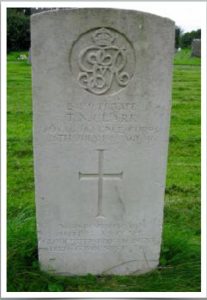259th Protection Company, Royal Defence Corps

It appears that Thomas Nelson Clark was born in Gloucester in or around 1870 and according to the CWGC Debt of Honour register his parents were William Nelson Clark and his wife Harriet.
Towards the end of 1892 he married Mary Ann Cox at Gloucester and they lived at 15 Dainty Street, Gloucester.
The 1911 census records that the couple had six children, sons William Nelson, Percival Benjamin, Alfred Benjamin, Reginald Thomas and Leslie Horace, with a single daughter Evaline Mary. The census states that two of the six children had died and these have been identified as Percival (born 1895, died 1896) and Evaline (born and died in 1911). Prior to enlisting in the Army, Thomas worked for eighteen years for Minchin & Sons, Grocers, in Westgate Street, Gloucester.
Unlike his Army Service Record, a Pension Record has survived for Thomas which reveals plenty of information on his Army career and discharge.
He attested for military service at the age of 45, at Gloucester on 25 January 1915 for an initial one year engagement in the Territorial Force, for service in the UK. He stated that he had previously served as a volunteer with the 1st Gloucestershire Royal Engineer Volunteers.
He joined the 5th Reserve Battalion of the Gloucestershire Regiment — National Reserve Company No 3 and was given the number 3916.
From the Long, Long, Trail website: In October 1914 the National Reserve was formed into ‘Protection Companies’, which were attached to existing TF battalions, for the guarding of railways and other vulnerable points in Britain. That November, all Class I and II men were ordered to present themselves for enlistment. In March 1915 the Protection Companies were redesignated as Supernumerary Companies TF. In July 1915 there was a wide scale trawl of these companies to identify men capable of marching 10 miles with a rifle and 150 rounds of ammunition. Those who wereclassified as medical Category A went to Service battalions, while Category C’s were posted to Provisional battalions.
Thomas would appear to have been classified as Category C and on 12 July 1916 (as a Category C2) he transferred to 259 Protection Company, Royal Defence Corps and was given the number 34159.
That particular company was assigned to Southern Command and its role would be guard duties, sometimes including prisoners of war.
In 1917 he developed dilated cardiomyopathy, where the heart muscles become stretched and thin and are unable to pump the blood around the body efficiently: he had also developed chronic bronchitis. This led to an appearance before a medical board at Banbury on 24 January 1918. His condition was put down to exposure in the course of ordinary military service and rated as a 20% disablement, sufficient to warrant discharge as permanently unfit for military service. An annotation in his medical papers reads: ‘he is 50 (sic) years of age – looks more’. Discharge followed on 21 February 1918 and he qualified for a Silver War Badge to denote previous military service and a disablement pension for an initial one year. He had served in the Army, all in the UK, for three years and 28 days. In May 1918 his disablement rating was raised to 30%.
Thomas Nelson Clark died aged 48 at home on 26 July 1918 which was most likely related to his cardiac condition. His death was reported in the Gloucester Journal on 3 August and this gave basic details of his previous military service. It also reported that three of his sons had seen military service during the war. The eldest, William Nelson, was wounded on the Somme in 1916 and had served for over two years with the Glosters before transferring to the Royal Air Force. Second son, Alfred Benjamin, had died on 15 July 1916, from wounds received when fighting with the 1st Battalion of the Glosters during the Somme Offensive.
He is buried at Heilly Station Cemetery, Mericourt – L’Abbe. A third son, Reginald Thomas, was serving with the Royal Field Artillery. Following his death, his widow received a Widow’s Grant of £6.
Thomas was buried in Gloucester Old Cemetery, where a standard Commonwealth War Graves Commission headstone marks his grave. It is inscribed with the words Also in memory of 21461 Pte. A B Clark, Gloucestershire Regiment, died of wounds 15 July 1916. Both father and son are commemorated on the Gloucester War memorial.
Researched by Graham Adams 31 October 2019
